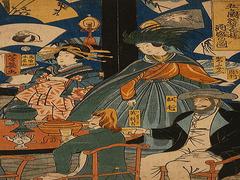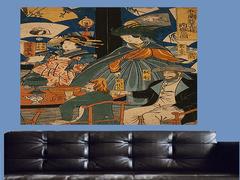The transition from the Edo period to the Meiji era (1868-1912) in Japan brought about profound social, political, and cultural changes. Amid the wave of modernization, traditional art forms like woodblock printing faced the challenge of adapting to a rapidly evolving world. This article delves into the story of Japanese woodblock printing's resilience and reinvention during a time of significant transformation.
Impact of Modernization
The Meiji Restoration marked a pivotal moment in Japan's history, ushering in a period of rapid industrialization, urbanization, and Westernization. As Japan embraced new technologies, ideologies, and international interactions, traditional art forms were at risk of fading into obscurity.
Transition to New Themes
In response to the shifting cultural landscape, woodblock printmakers began to explore new themes that aligned with modern sensibilities. While traditional subjects like kabuki actors and courtesans persisted, artists also started depicting modern urban scenes, Western-style fashions, and emerging industries. This adaptability allowed woodblock printing to maintain its relevance in the changing times.
Shin Hanga: A Reinterpretation
The early 20th century witnessed a movement known as Shin Hanga, which sought to rejuvenate woodblock printing through a blend of tradition and innovation. Shin Hanga artists embraced a revival of traditional techniques while infusing their works with contemporary subject matter. This movement not only provided a fresh perspective on Japanese landscapes and culture but also enabled the survival of woodblock printing in a modern world.
Preserving Craftsmanship
Even as new technologies emerged, there were individuals who recognized the importance of preserving traditional craftsmanship. These artists and printmakers continued to adhere to time-honored methods, valuing the intricate process of carving and printing by hand. Their dedication ensured that the techniques of woodblock printing would be passed down to future generations.
Influence on Modern Art
Japanese woodblock printing's adaptability and distinct aesthetics inspired modern artists worldwide. The flat perspectives, bold lines, and vibrant colors found in ukiyo-e prints resonated with the Cubist movement and Fauvist color theory. Artists such as Henri Toulouse-Lautrec and Édouard Manet incorporated elements of Japanese woodblock prints into their works, contributing to a cross-cultural exchange that enriched Western art.
Enduring Legacy
Today, Japanese woodblock printing stands as a testament to the resilience of artistic traditions in the face of modernization. Museums and galleries around the world showcase these prints, reminding audiences of the art form's ability to evolve while retaining its essence. Contemporary artists continue to draw inspiration from woodblock techniques, preserving the link between past and present.
Conclusion
The story of Japanese woodblock printing's resilience and reinvention mirrors the broader narrative of a nation grappling with change. The art form's ability to adapt, innovate, and inspire serves as a testament to the enduring power of human creativity and the profound connection between artistic expression and the zeitgeist of an era. As we look back on this journey, we recognize that the legacy of woodblock printing transcends time, embodying the spirit of adaptation and resilience in the face of transformation.
- Beyond Ukiyo-e: The Diverse Landscape of Japanese Woodblock Art
- Evolution of Japanese Woodblock Printing: Tracing the Roots of an Artistic Tradition
- From Edo to the World: How Japanese Woodblock Prints Shaped Western Art and Culture
- Japanese Woodblock History
- Masters of the Blade and Block: The Collaborative Artistry of Samurai and Woodblock Printmakers
- Resilience and Reinvention: Japanese Woodblock Printing in the Face of Modernization
- Techniques and Traditions: Unraveling the Intricacies of Japanese Woodblock Printmaking
- The Influence of Nature in Japanese Woodblock Prints: Depicting Seasons and Symbolism
- The Societal Mirror: Reflecting Daily Life in Edo Period Woodblock Prints
- The Woodblock Artisans of Edo: Masters of Craftsmanship and Creativity
- Ukiyo-e Renaissance: Exploring the Golden Age of Japanese Woodblock Prints




